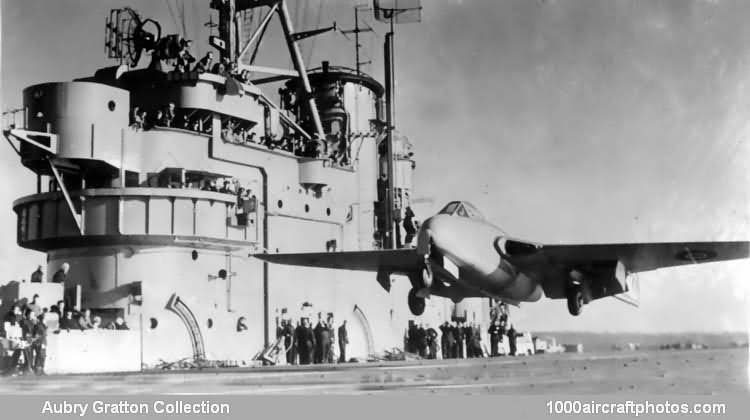05/31/2010. Remarks by Johan Visschedijk: "de Havilland's first jet-powered aircraft was the Vampire, produced to an experimental specification E.6/41, but with provision for carrying armament. Built under great secrecy at Hatfield, the Vampire was powered by a 2,700 lb (1,225 kg) st de Havilland Goblin I centrifugal jet engine, and featured wooden fuselage structure similar to the Mosquito with tapered un-swept metal wings, twin tail booms and tail surfaces. The twin boom layout gave maximum efficiency to the low-powered engine. Despite being a new airframe with a new type of propulsion, it proved successful enough on flight trials to be developed into a fighter.
Three prototypes were built, the first (s/n LZ551) flew September 20, 1943, the second (s/n LZ551) was modified for naval use and became the first carrier-borne jet aircraft after carrying out deck trials on HMS Ocean on December 3, 1945, while the third (s/n MP838) was armed with four under-fuselage-mounted 0.787 in (20 mm) cannon. The Vampire was the second British jet fighter to fly, and the first British aircraft to exceed 500 mph (805 kmh), but was too late for combat in WW II. The English Electric Company at Preston started series production to the initial contract for 120 (later 300) Vampire F.Mk.I fighters, the first entered service in April 1946.
The improved Vampire F.Mk.3 was designed to specification F.3/47 with better longitudinal stability and strengthened wings for the carriage of under-wing stores, and in July 1948, six Vampire F.Mk.3s of No. 54 Squadron became the first jet aircraft to fly across the Atlantic. The major production version was the 3,100 lb (1,406 kg) st Goblin 2 powered Vampire FB.Mk.5, adapted for low level ground attack with reduced span and provision for the carriage of bombs or rockets under the wings, while the Vampire FB.Mk.9 was developed for use in the hotter climates featuring a 3,500 lb (5,633 kg) st Goblin 3 engine and a refrigeration unit to keep the cockpit cool.
The single-seat Vampires, with their docile handling and lack of complication, made good training aircraft to prepare pilots for Vampire, Venom and Hunter operations. They served with a number of Flying Training Schools (FTS) and Operational Conversion Units (OCU). As a result of the successful deck trials, the Royal Navy ordered six Vampire development aircraft and a further 30 production aircraft, known as the Sea Vampire F.Mk.20. This version was fitted with an arrester hook and stronger landing gear, and its modest size avoided the need for wing folding. The first production Sea Vampire F.Mk.20 was flown in October 1948.
A further experimental naval development was the Sea Vampire F.Mk.21 adapted for operations from rubber mats without the use of the normal landing gear to save structural weight. Trials were carried out at Farnborough and on board the carrier HMS Warrior early in 1949, but damage to the aircraft and their immobility resulted in the idea being abandoned.
The Vampire was also adopted by many overseas air forces, either directly from Britain, or produced under license. The Swedish Government were the first overseas customer when they placed an order in February 1946, to be followed five months later by the Swiss. Their initial orders were for the Vampire F.Mk.1, but later batches were the Vampire F.Mk.6, an export version of the Vampire FB.Mk.5.
One of the largest Vampire customers was France, where it was adapted and produced under license as the Sud-Est S.E.535 Mistral powered by a French-built Rolls-Royce Nene engine. License production was also undertaken in Australia (de Havilland Australia), India (Hindustan Aircraft Ltd.) and Italy (Fiat/Macchi). Other countries to use the Vampire were Canada (surplus later acquired by Dominica and Mexico), Ceylon, Egypt, Finland, Iraq, Lebanon, New Zealand, Norway, South Africa, Southern Rhodesia, and Venezuela, and production closing at over 3,000 aircraft."
